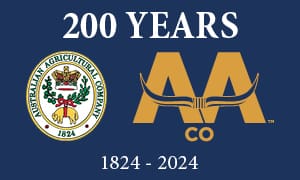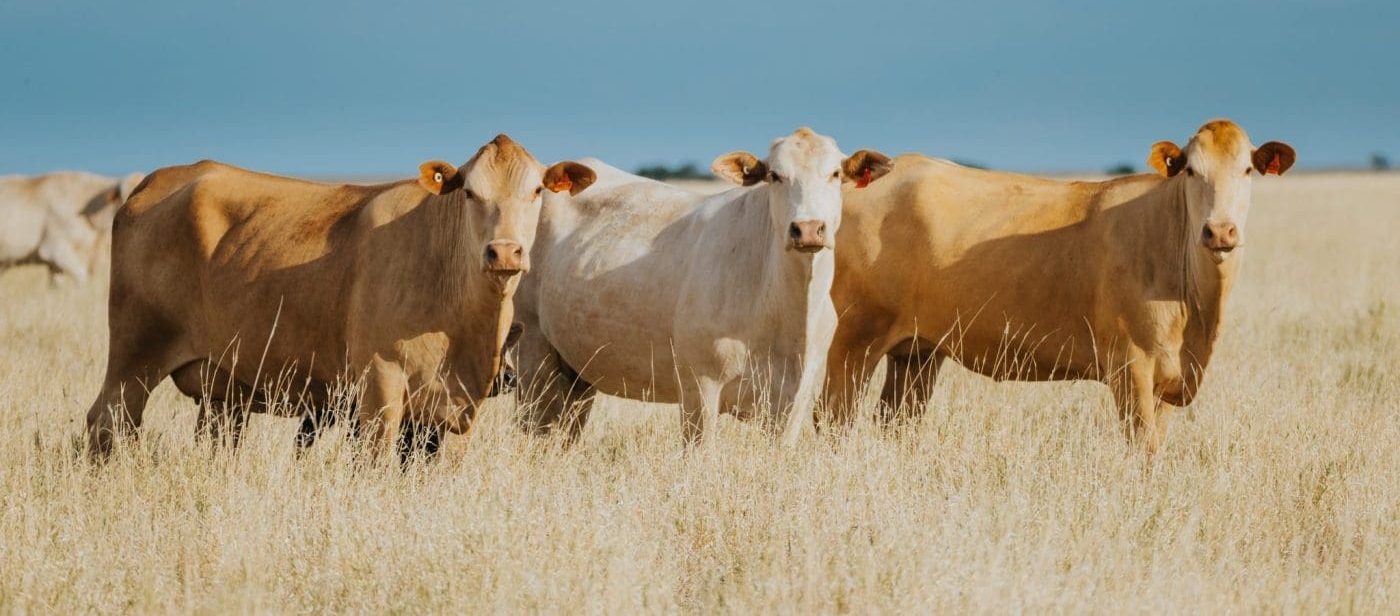 As part of the Australian Agricultural Co’s 200th anniversary this year, Beef Central is publishing a series of articles on the world’s largest cattle producer’s beef genetics history. In this four-part series, we are chronicling AA Co’s progression through its Shorthorn, Santa Gertrudis, Composite and Wagyu eras. Today’s third instalment looks at the Composite era.
As part of the Australian Agricultural Co’s 200th anniversary this year, Beef Central is publishing a series of articles on the world’s largest cattle producer’s beef genetics history. In this four-part series, we are chronicling AA Co’s progression through its Shorthorn, Santa Gertrudis, Composite and Wagyu eras. Today’s third instalment looks at the Composite era.
Click here to read the previous item in the series on the Santa era, or click here to read about the company’s genetic roots 200 years ago in Shorthorns

Composite-bred cattle on AA Co’s Barkly country
JUST as the Australian Agricultural Co had moved from its original roots in Shorthorn genetics to Santa Gertrudis in the 1970s for productivity reasons, a new genetic path arrived for the company in the 1990s.
Part of the catalyst was the establishment of the company’s first feedlot at Meteor Downs, near Comet in Central Queensland in 1990.
The company also held custom-feeding space at a number of other large Queensland feedyards at the time, and later in 2002, purchased a second feedlot at Aronui, near Dalby.
AA Co had a footprint in the grain-finishing sector long before most large northern pastoral operators, with the exception of the North Australian Pastoral Co, which had established a small feedot at Wainui near Bowenville in 1957.
With a vision emerging to retain ownership of grainfed cattle further through the supply chain, suddenly, meat quality was re-positioned as a greater priority within the AA Co’s breeding operations.
As good as AA Co’s enormous Santa and Brahman herds were, the company could see meat quality performance and fertility opportunity in the establishment of a composite beef herd, and the company’s advances into lotfeeding only heightened the interest.
 It could be argued that the same motivation – continuing to move up the meat quality scale – has driven the company’s final genetics era, in Wagyu (final story in this series to come)
It could be argued that the same motivation – continuing to move up the meat quality scale – has driven the company’s final genetics era, in Wagyu (final story in this series to come)
Done well, a large-scale composite breeding program could harness the majority of the ‘free-kick’ hybrid vigour effect available in classic terminal crossbreeding, without all the associated management hassles, research had shown.
The move into composite breeding happened in a number of stages, starting in the early 1990s.
Just prior to the advent of the composite breeding projects, AA Co put Black Angus bulls over Santa cows on its Headingly station southwest of Mt Isa, to produce a terminal cross animal. Further north at Austral Downs near Camooweal, a similar program saw Charolais bulls over Santa cows in a terminal cross, to go through the recently purchased Goonoo feedlot.
Elsewhere the company imported five Senepol bulls (tropically adapted Bos Taurus) from the US for use over elite Santa cows at Brunette Downs, at one time becoming one of the largest Senepol breeders in Australia.
The first true, methodical composite breeding program did not emerge until a few years later.
In 1999, as part of its 175th birthday celebrations, AA Co commissioned a company history, titled “In Good Company.”
In it, a passage refers to the establishment in 1994 of a 1000 head artificial breeding centre at Meteor Downs on Queensland’s Central Highlands – at the time the largest such breeding facility in Australia.
“It was decided to develop two composite breeds – one for the Barkly and the other for the Gulf stations, which led to the sale of the Santa Gertrudis stud in 1997,” the booklet said.
“The aim of the composite program was to develop a tropically-adapted breed-type, producing excellent eating quality beef with some marbling potential, while retaining heterosis (hybrid vigour) to improve growth, carcase yield and fertility,” it said.
Charolais and Red Angus semen was used over Brahman cows in artificial insemination programs to produce the first cross, the document said. “These F1s were reciprocally crossed with adapted breeds such as Senepol, Tuli, Belmont Red, and Bonsmara to create an animal with improved eating quality characteristics while retaining adaptability to northern Gulf conditions.”
This composite was in turn used over first-cross Santa x Senepol females to produce the softer composite suitable for the Barkly region.
Part of AA Co’s push into composite genetics coincided with its launch of the 1824 100-day grainfed branded beef program – still arguably among the largest and most ambitious (funding and marketing wise) beef brands in the industry’s history. The company also bought a large meat portioning, value-adding and distribution business in Brisbane as part of its push further along the value-chain.
After considerable research (genetics consultant Don Nicol worked closely with AA Co for many years in the program’s development) two separate composite programs were developed.
The softer Barkly composite had a Santa base, with mostly Senepol and Charolais genetics, while the Gulf composite had a higher Indicus content from the foundation Brahman breeders, with Charolais and Senepol, some with a splash of Red Angus.

AA Co composite breeders on the Barkly Tableland
Managers struggled with genetic redirection
However, as happened during company’s original move from its Shorthorn roots into Santas in the 1970s, there was some push-back from property managers and others who were reluctant to abandon their much-loved Santa and Brahman straightbred herds.
“Some managers really struggled with the transformation,” said Geoff Wagstaff, who spent 26 years as a senior manager with AA Co from 1979 recalls.
“Everyone was so proud of their big runs of even red steers, walked off the Barkly down to South Galwey or Brighton Downs in the Channels,” he said.
“In those days, coat colour was important. Staff took a lot of pride in producing a big run of peas-in-a-pod red Santa cattle. There was a sense of pride, but colour changed very quickly when the composite bulls arrived,” he said.
The Barkly herds were still predominantly Santa-based in the early 2000s, but gradually the herd type evolved as the new composite program kicked in.
“The weight of the first rounds of composite cattle did not change much from the earlier Santas, but the eating quality performance (especially marbling) did,” Mr Wagstaff said
He agreed that the calving percentage performance being recorded by the earlier North Australian Pastoral Co composite program no doubt also influenced AA Co to embrace its own composite program.
As history records, AA Co’s composite era flourished for around 15 years, before around 2005, when the first black F1 Wagyu x composite calves started to appears in northern company breeding paddocks, as the final ‘Wagyu era’ started to took hold.
While AA Co’s genetic ‘signature’ is now squarely aligned with its Wagyu breeding, feeding and marketing programs, composite breeders with no Wagyu genetic content continue to play a strong part in some of the company’s breeding operations to this day.
The composite breeder provides an excellent building block for AA Co’s F1 Wagyu programs, delivering a foundation of good eating quality performance on which to overlay some Wagyu marbling.
‘Directed evolution’
Pondering the company’s future direction, the company’s 175th anniversary booklet published back in 1999 said through genetic selection, ‘directed evolution’ and biotechnology, AA Co’s beef production efficiency and quality had been elevated – and the future held great expectation and excitement in this area for the company.
With the introduction of superior genetics, AA Co had the potential to produce “ten steaks out of ten” that are good to eat and food-safe, the 175th anniversary booklet said.
“This beef will be produced from cattle that have the genetics to be potentially the best in the tropical world. Senior managers will have the difficult task of choosing which technology to adopt.
The full potential of genetics advances is yet to be seen,” it said.
Still to come in this series: AA Co’s final Wagyu era, with input from Don Mackay, Greg Gibbons and David Harris.
Click here to access previous items on AA Co’s Shorthorn origins, and its Santa Gertrudis and Brahman era.
